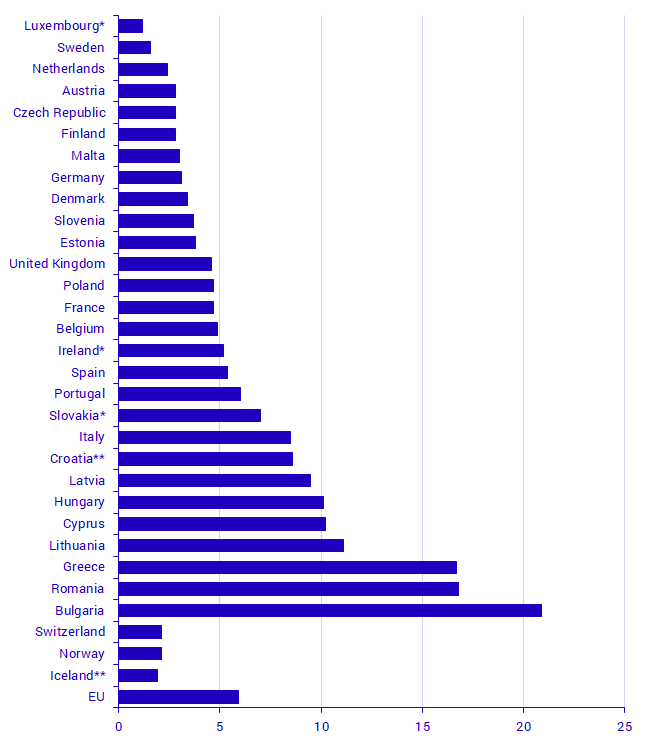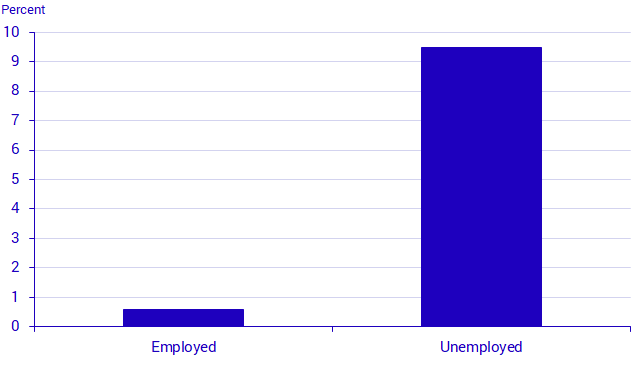Living Conditions Survey (ULF/SILC)
Sweden’s rate of material deprivation is lower than in most other European countries
Statistical news from Statistics Sweden 2019-10-16 9.30
Two percent of the population in Sweden lives in conditions of severe material deprivation according to the EU definition; the EU average is six percent. Unemployed persons live in conditions of severe material deprivation to a greater extent than employed persons. Material deprivation is also more common among foreign born persons than among Swedish born persons.
In connection with the United Nations International Day for the Eradication of Poverty on 17 October, Statistics Sweden is publishing some of the indicators used by the European Union to monitor the risk of poverty and social exclusion.
Sweden and Luxembourg report the lowest share of the population living in conditions of severe material deprivation, between one and two percent. Bulgaria reports the highest share, 21 percent, in 2018.
Severe material deprivation is defined as not being able to afford at least four of nine items. For example, the inability to afford unexpected expenses or adequate heating of the home, or the inability to make timely payments.
The share of persons in Sweden living in conditions of severe material deprivation has held at 1-2 percent in recent years. This corresponds to about 160 000 persons who lived in conditions of material deprivation in Sweden in 2018.

Source: Eurostat, EU-SILC *The latest data refers to 2017. **The latest data refers to 2016.
In Sweden, severe material deprivation is most common among unemployed persons; among unemployed persons, ten percent - compared with one percent among employed persons - live in conditions of severe material deprivation. It is also more common among foreign born persons than among Swedish born persons - four percent compared with just under one percent.

Source: Eurostat, EU-SILC
Other results from the EU-SILC
- In Sweden, about seven percent of the population answered that housing costs are a heavy burden on the household economy. That is one of the lowest percentages in the EU; in most countries, more than 20 percent of the population answered that housing costs constitute a heavy burden.
- In Sweden, just over 14 percent of the population face problems of crime, violence or vandalism in their neighbourhood. This share is higher than in many other countries in Europe. In Sweden, Cyprus and Germany, a larger share of the population experience problems of crime, violence or vandalism than in 2010. In many other countries, the trend has been the reverse or unchanged.
- In Sweden, about 12 percent of Swedish born persons and 37 percent of persons born outside the EU have an annual income after tax below the at-risk-of-poverty threshold. For the entire EU, the corresponding share of persons with an income below the at-risk-of-poverty is 15 percent among persons born in a Member State country and 31 percent among persons born outside the EU.
More about the statistics
The EU-SILC (European Union Statistics on Income and Living Conditions) is a statistical survey that is conducted annually in the EU countries and several other countries. The survey has been a part of the Survey on Living Conditions since 2008 and enables international comparisons. More results are presented on Eurostat’s website, under: Population and social conditions/Living conditions and welfare/Income and living conditions.
Definitions and explanations
Severe material deprivation is defined as the inability to afford a certain standard of living. This is measured by examining whether people are able to pay unexpected expenses, a one-week annual holiday, a meal with meat, chicken or fish (or vegetarian equivalent) every second day, adequate heating of a dwelling, durable goods, such as a washing machine, a colour television set, telephone, and car, or are able to make payment arrears (mortgage or rent, utility bills, purchase instalments, or other loan payments). A person living in conditions of severe material deprivation cannot afford at least four of these nine items. This measure is one of three overall measures followed up annually by the EU with a view to decrease the number of people at risk of poverty or social exclusion in Europe by 2020.
The EU’s risk of poverty indicator is a relative measure of income poverty. Under this definition, an individual with a disposable income (salary, wage, pension, contributions, and so on) below 60 percent of the country’s median income is considered to be at risk of poverty. This indicator does not measure low standard of living or poverty, but rather low income rates in relation to other people in the country.
Statistical Database
More information is available in the Statistical Database
Feel free to use the facts from this statistical news but remember to state Source: Statistics Sweden.
